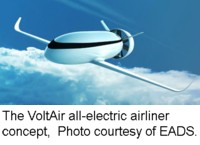Here Comes the Electric Plane
 The
TheTxchnologist, the GE-sponsored online magazine, wraps up
its aviation month with a week devoted to space travel, including
this far-out feature on the E-Plane:
Confronted with substantially the same environmental mandates
that prompted the auto industry to develop electric cars, the
aviation industry has begun gearing up to do the same. That’s
right, electric airplanes are coming.
EADS (European Aeronautic Defense and Space Company), the parent
firm of Airbus, for example, has been flying a battery
electric-powered ultralight aircraft for the last year, and at the
recent Paris Air Show it introduced a series-hybrid motor glider as
well as an ambitious future concept for an all-electric, 50-seat
passenger plane powered by superconducting drive motors.
Last fall, Boeing released details of a NASA-funded effort to
use a hybrid battery-electric/gas turbine propulsion system to
power a future 737-class commercial transport.
A few months earlier, at the 2010 Oshkosh event, both Cessna and
Sikorsky announced plans to fly some time this year
electric-powered demonstrators-respectively, a light plane and a
light helicopter.
A slow transition to electric
Aviation experts say that ultra-green aviation technology will
take a good deal of time. The necessary technical advances are
still speculative. On the other hand, they add, aerospace engineers
can see the path to eventual success, if not the actual stepping
stones along the way.
“Next-generation aircraft will feature more and more
electronics,” said Dale Carlson, Executive for Advanced Engine
Systems at GE Aviation, but “the last thing to convert to electric
power will be the power plant. This is because the batteries that
would be required to supply the amount of electricity for large
commercial aircraft, weigh a lot.”
The power capacity of battery technology, he continued, would
have to grow by “at least a factor of four before we are near where
we need to be to accomplish this.” Larger electric airliners would
need hundreds of thousands of horsepower.
“Game changer”
Still, many researchers can already envision how the switch to
electric will take place. Electric propulsion will be a
“game-changer and transform aeronautics in the next 20 to 30
years,” predicted Mark Moore, an aerospace engineer and conceptual
design expert at NASA Langley Research Center.
The first breakthroughs will occur with small aircraft,
according to Moore, perhaps personal air vehicles that could
replace the car on some trips. He envisions electric-powered
unmanned aerial vehicles first transitioning from military to
civilian use, followed in time by much more environmentally
responsible commercial transport planes.
Carlson speculated that at some point “we’ll probably see a
hybrid engine that combines fuel cells with turbines-where the
turbine technology would be there for takeoff and the fuel cells
utilized during cruise.”
* Steven Ashley is a contributing editor at Scientific
American magazine, where he writes and edits articles on general
science and technology topics. Ashley’s work has been published in
Popular Science, MIT’s Technology Review and Physics Today, among
others.
Source: www.gereports.com

